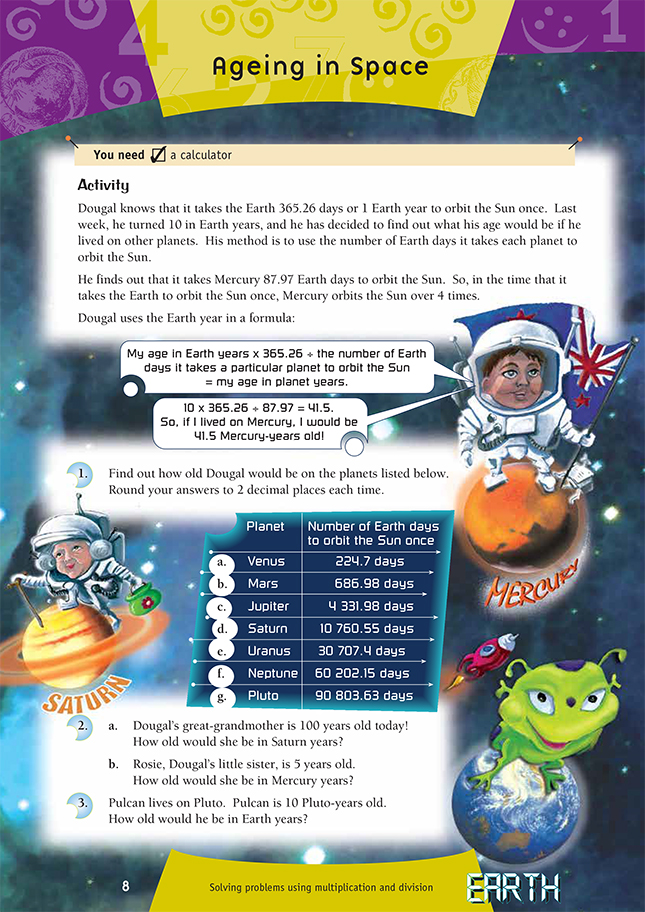This is a level 5 number activity from the Figure It Out series. It relates to Stage 8 of the Number Framework.
A PDF of the student activity is included.
Click on the image to enlarge it. Click again to close. Download PDF (230 KB)
solve multiplication and division problems involving decimals
FIO, Level 3-4, Number, Book 2, Ageing in Space, page 8
Calculator
This activity gives students some interesting facts about how our ages are calculated and relates these facts to other planets and the time they take to orbit the Sun. The activity requires rounding to 2 decimal places, applying a given formula, and manipulating that formula. It differs from other activities in the students’ book in that, rather than focusing on mental strategies, it focuses on the ability to understand and work with formulae, to round to 2 decimal places, and to work with large and complex numbers. The numbers involved cannot be easily manipulated using mental strategies, so the students will need to use a calculator. However, they will need to use advanced multiplicative knowledge of number properties, especially for questions 2 and 3, in which they must choose the calculation required to solve each problem. The activity also draws on their number sense because they need to know whether the answer they get on the calculator is a reasonable one.
Question 1 asks the students to round their answers to 2 decimal places. This is a good opportunity to teach or reinforce this skill. If the third digit after the decimal point is 5 or more, the second digit after the point is rounded up. For example, 24.6571 becomes 24.66 (2 d.p.), and 18.995 becomes 19.00 (2 d.p.). (Note that this latter example is not written as 19 because the answer required 2 decimal places.) However, if the third digit after the point is less than 5, the second
digit after the point is unaltered. For example, 2605.932 becomes 2605.93 (2 d.p.). To minimise error when doing a calculation, avoid rounding until you reach the final answer.
Before the students start the activity, you may want to discuss with them how the approximately 365.26 days in an Earth year are handled on our calendar. (We have a leap year [in which there are 29 days in February instead of 28] every 4 years to catch up the 4 quarter days.)
Dougal uses a formula to work out his age in planet years:
The students use this formula for questions 1 and 2, inserting the relevant age and planet information. Encourage the students to recognise that multiplying a decimal number by 10 (Dougal’s age) or 100 (his great grandmother’s age) is effectively the same as shifting all the numbers 1 or 2 places respectively to the left. This then takes a step out of Dougal’s formula, which makes the calculation process faster and easier.
For question 3, in which the known information is Pulcan’s age in Pluto years, the students need to rearrange the formula so that they can calculate the unknown information (Pulcan’s age in Earth years). A student who can “see” the relationship and manipulate the formula on their own is developing the algebraic thinking needed to calculate the “unknown”.
Students who need help with this question may follow the rearrangement of the formula more easily if you show it to them in a 3-step process. The original formula with Pulcan’s age as the known information is:
Step 1:
Reverse the formula:
Step 2:
Change the division on the right-hand side to multiplication on the left:
Pulcan’s age in Pluto years x Earth days for Pluto to circle the Sun = Pulcan’s age in Earth years x 365.26.
Step 3:
Change the 365.26 from multiplication on the right-hand side to division on the left-hand side:
From the table at question 1, we know that Pluto takes 90 803.63 Earth days to circle the Sun.
So the formula is now:
So Pulcan is 2 486.00 (2 d.p.) years old in Earth years.
Answers to Activity
1. a. 16.26 Venus-years old
b. 5.32 Mars-years old
c. 0.84 Jupiter-years old
d. 0.34 Saturn-years old
e. 0.12 Uranus-years old
f. 0.06 Neptune-years old
g. 0.04 Pluto-years old
2. a. 3.39 Saturn-years old (2 d.p.). (100 x 365.26 ÷ 10 760.55)
b. 20.76 Mercury-years old (2 d.p.). (5 x 365.26 ÷ 87.97)
3. 2 486.00 Earth-years old (2 d.p.). (10 ÷ 365.26 x 90 803.63)
